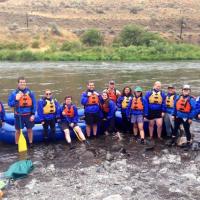Precision Agriculture Resources for Farmers
I had an amazing experience this summer! I had the chance to work as an undergraduate intern with REACCH Extension Specialist, Kristy Borrelli. Coming from the city of Chicago, I was in awe of the rolling hills in the Palouse but did not know much about grower practices, much less precision agriculture. Over the nine-week period, I researched precision agriculture equipment and practices in the inland Pacific Northwest.
Precision Agriculture
Precision agriculture (or site-specific farming) (PA) basically allows farmers to address the variability in their own field. Most farmers treat input applications and fields uniformly. This can be an issue since yields vary along slopes and soils of the field.
Concerns associated with farming on hills:
- Loss of organic matter
- High amounts of clay and high bulk density
- Reduced water infiltration, plant nutrients and beneficial biota
By adopting precision agriculture practices, growers can reduce unwanted environmental effects! Did you know 75% of US Nitrous Oxide (N2O) emissions come from agriculture? By targeting locations of inputs like nitrogen, growers do not have to apply too much or too little. PA can reduce reactive nitrogen in soil, which will prevent N2O emissions that is a strong greenhouse gas. And it saves money because the producer is not wasting inputs.
Precision agriculture technologies include:
- Precision Ag software
- GPS guidance
- Yield monitors
- Aerial imagery
- Variable rate applications
Methods and Goals of Research
There is too much information today about PA. My goal was to find meaningful information about PA that farmers can take into consideration. I hoped to narrow the communication gap between developers and users. One of the biggest issues I found was growers do not have the time to alter their practices and manage new equipment, while keeping their farm going. I had the chance to talk to five different researchers who were knowledgeable about PA and asked them questions that growers might ask at a field day (summarized below).
Recommendations for PA adoption and management:
- Manage zones: Identify 2-3, keep it simple.
- The most important technologies
- Auto boom allows growers to control where fertilizers or pesticides are sprayed in the field by avoiding overlap of applications.
- Remote sensing helps us see more of our crop than the naked eye. If grain doesn’t have sufficient nutrients, technology can help identify where it is most lacking.
- Yield maps describe where production is high or low. These are usually produced with data collected by the combine, so it does not effect this year’s crop. However using this information, producers can objectively see the places where it is better to invest more or less in fertilizer.
- Global Positioning System (GPS) is the crux of PA technology
- Have a goal in mind and stick to it and be sure to “Evaluate, Evaluate, Evaluate!”
What is it that the grower would like to achieve by the end? Set a goal for the season, stick to it and evaluate how it worked in the end? Make necessary adjustments for the next season. Growers can also run test plot using custom equipment or a neighbor’s equipment.
- Be true to complications and the willingness to commit: If necessary, consider an outside source such as an consultant.
- Be careful and patient for data: To accurately understand the field, an accumulation of data over many years is important.
- Interest in technology among the family: Interested family members can help invest time and troubleshoot ideas about technology and management.
- Search video tutorials: Online resources can offer visual representation of handling equipment and other information.
Perhaps we can continue narrowing the communication gap of PA by highlighting grower’s successes that have PA technology and creating case studies. We can also have more growers at field days. Perhaps implementing climate change education to consultants and the industry will have a better understanding of the nitrous oxide emissions.
Personal Experience:
I had a blast in Moscow, Idaho! I feel like a changed person when I head back to city (I found it strange to not have cross through a toll way, buying things in bulk, free parking spots, and the amazing farmer’s market every Saturday!). I have achieved beyond my personal goals that I had set in the beginning. I was exposed to different options to graduate school (thanks to Jodi Johnson-Maynard and Janet Rachlow). This experience definitely had an impact to my future career goals. I realized how incredibly valuable the Extension team is to any program.
This was the first year I worked with social science and qualitative data, there were some challenges. However, I was incredibly impressed of the results I found by the end of my internship. I really hope to incorporate Extension and communication to any career path I choose in whether in conservation, ecology, and/or sustainability in the future. I realize how communicating and teacher science is important to me. I believe my social skills interacting with growers, researchers, teachers and my peers definitely have changed. I am incredibly surprised at my knowledge of applying agriculture to climate change. I have met amazing people participating in the REACCH program that inspired me as a young student. It was such an honor to meet and interact with many others throughout the REACCH interdisciplinary program.
REACCH Undergraduate Summer Interns come from all over the country to spend 9 weeks with REACCH scientists conducting research, gaining job and graduate school training, and sharing their experiences. These blogs are the culmination of their research experience.


